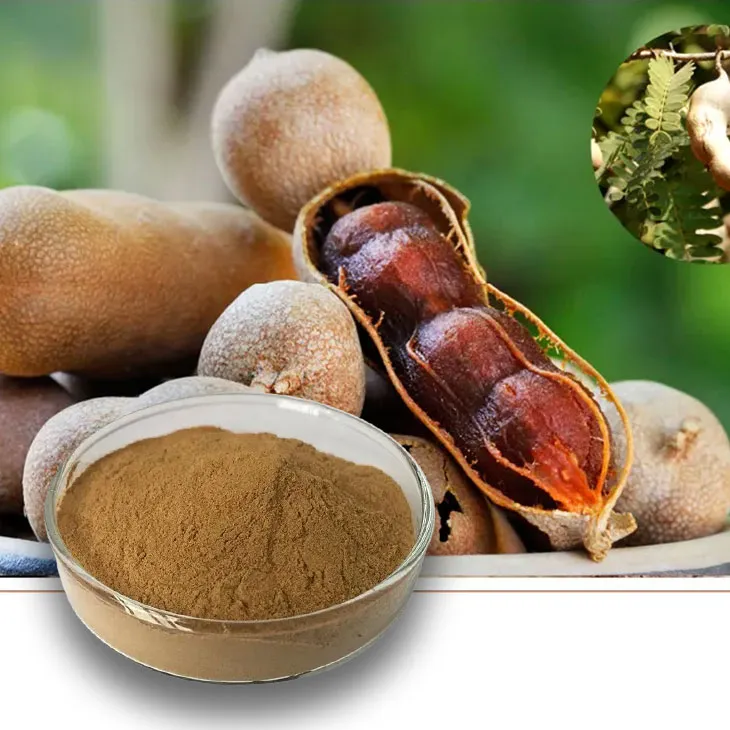- 0086-571-85302990
- sales@greenskybio.com
Active ingredients in tamarind extract powder.
2024-11-26

1. Introduction
Tamarind extract powder is a natural product that has been gaining increasing attention due to its various potential applications. It contains a rich variety of active ingredients that contribute to its diverse properties. In this article, we will explore the main active ingredients in Tamarind extract powder and their significance in different fields.

2. Polysaccharides in Tamarind extract powder
2.1 Immunomodulatory Properties
One of the most prominent active ingredients in tamarind extract powder is polysaccharides. These polysaccharides possess immunomodulatory properties, which play a crucial role in influencing the immune system. The immune system is our body's defense mechanism against various pathogens such as bacteria, viruses, and fungi. The polysaccharides in tamarind extract powder can enhance the body's defense mechanisms, making it more resistant to infections.
For example, they can stimulate the activity of immune cells such as macrophages and lymphocytes. Macrophages are the first line of defense in the immune system, responsible for engulfing and destroying foreign invaders. Lymphocytes, on the other hand, are involved in the specific immune response, including the production of antibodies. By enhancing the function of these immune cells, the polysaccharides in tamarind extract powder can help the body to better combat infections.
2.2 Other Potential Benefits
Besides immunomodulation, the polysaccharides in tamarind extract powder may also have other beneficial effects. Some studies suggest that they may have anti - inflammatory properties. Inflammation is a natural response of the body to injury or infection, but chronic inflammation can lead to various diseases such as arthritis, heart disease, and cancer. The anti - inflammatory properties of the polysaccharides may help to reduce chronic inflammation and thus contribute to overall health.

3. Vitamin C in Tamarind Extract Powder
3.1 Immune - Boosting Function
Tamarind extract powder also contains vitamin C, which is a well - known antioxidant. Vitamin C is essential for a healthy immune system. It can enhance the function of white blood cells, which are the key players in the immune response. White blood cells are responsible for identifying and destroying pathogens. By increasing the activity of white blood cells, vitamin C can help the body to fight off infections more effectively.
3.2 Collagen Synthesis and Skin Health
Another important function of vitamin C is its role in collagen synthesis. Collagen is a protein that provides structure and strength to various tissues in the body, especially the skin. It is responsible for keeping the skin firm, elastic, and smooth. Vitamin C is required for the hydroxylation of proline and lysine, two amino acids that are essential for collagen formation. Without sufficient vitamin C, collagen synthesis is impaired, which can lead to skin problems such as wrinkles, sagging, and poor wound healing.
3.3 Wound Healing
Vitamin C also plays a crucial role in wound healing. It is involved in the formation of new blood vessels, which are necessary for supplying oxygen and nutrients to the wound site. In addition, it helps to strengthen the connective tissue at the wound site, promoting the closure of the wound. A deficiency in vitamin C can slow down the wound healing process, making the body more susceptible to infections at the wound site.

4. Amino Acids in Tamarind Extract Powder
4.1 Building Blocks of Proteins
The presence of amino acids in tamarind extract powder is another important aspect of its composition. Amino acids are the building blocks of proteins. Proteins are essential for various physiological functions in the body, including cell repair and growth. There are 20 different amino acids that are required by the body, and some of them cannot be synthesized by the body and must be obtained from the diet.
The amino acids in tamarind extract powder can contribute to the synthesis of proteins in the body. For example, they can be used to repair damaged cells and tissues. When the body is injured or undergoes stress, cells are damaged, and proteins are broken down. The amino acids from tamarind extract powder can be used to replace the damaged proteins and repair the cells, promoting the recovery of the body.
4.2 Role in Physiological Functions
In addition to cell repair and growth, amino acids are also involved in other physiological functions. For example, some amino acids are neurotransmitters or precursors of neurotransmitters. Neurotransmitters are chemicals that transmit signals between nerve cells in the brain and nervous system. They are essential for normal brain function, including mood regulation, memory, and cognitive function. The amino acids in tamarind extract powder may thus have an impact on brain health and function.

5. Applications of Tamarind Extract Powder in Different Industries
5.1 Health Industry
Due to its active ingredients such as polysaccharides, vitamin C, and amino acids, tamarind extract powder has potential applications in the health industry. It can be used as a dietary supplement to boost the immune system, improve skin health, and promote wound healing. For example, it can be formulated into capsules or tablets for easy consumption. It may also be used in functional foods such as energy bars or smoothies to provide additional health benefits.
5.2 Food Industry
In the food industry, tamarind extract powder can be used as a natural flavoring agent. It has a unique sour - sweet taste that can enhance the flavor of various foods and beverages. It can be added to sauces, marinades, and dressings to give a tangy flavor. In addition, it can also be used as a natural preservative due to its antioxidant properties. Antioxidants can prevent the oxidation of fats and oils in food, which can cause rancidity and spoilage.
5.3 Cosmetics Industry
The properties of tamarind extract powder also make it suitable for use in the cosmetics industry. Its vitamin C content can help to brighten the skin and reduce the appearance of dark spots. The polysaccharides may have moisturizing and anti - aging effects on the skin. It can be incorporated into skincare products such as creams, lotions, and serums to improve skin health and appearance.
6. Conclusion
Tamarind extract powder contains several important active ingredients such as polysaccharides, vitamin C, and amino acids. These active ingredients endow the powder with various properties, including immunomodulatory, antioxidant, and protein - building functions. These properties make tamarind extract powder a potentially valuable natural product with diverse applications in the health, food, and cosmetics industries. However, more research is needed to fully understand the mechanisms of action of these active ingredients and to explore their potential applications further.
FAQ:
What are the main active ingredients in tamarind extract powder?
The main active ingredients in tamarind extract powder include polysaccharides, vitamins (such as vitamin C), and amino acids.
How do the polysaccharides in tamarind extract powder affect the immune system?
The polysaccharides in tamarind extract powder have immunomodulatory properties. They can enhance the body's defense mechanisms against pathogens, thus helping in preventing infections.
What role does vitamin C in tamarind extract powder play?
Vitamin C in tamarind extract powder is a well - known antioxidant. It can boost the immune system, promote collagen synthesis for healthy skin, and help in wound healing.
Why are amino acids in tamarind extract powder important?
Amino acids are the building blocks of proteins and are necessary for various physiological functions in the body, including cell repair and growth.
What are the potential applications of tamarind extract powder?
Tamarind extract powder has potential applications in health, food, and cosmetics industries due to the combination of its active ingredients.
Related literature
- Analysis of Active Compounds in Tamarind Extract"
- "The Role of Tamarind Extract Powder in Immune Modulation"
- "Tamarind Extract: A Review of Its Active Ingredients and Applications"
- ▶ Hesperidin
- ▶ Citrus Bioflavonoids
- ▶ Plant Extract
- ▶ lycopene
- ▶ Diosmin
- ▶ Grape seed extract
- ▶ Sea buckthorn Juice Powder
- ▶ Fruit Juice Powder
- ▶ Hops Extract
- ▶ Artichoke Extract
- ▶ Mushroom extract
- ▶ Astaxanthin
- ▶ Green Tea Extract
- ▶ Curcumin
- ▶ Horse Chestnut Extract
- ▶ Other Product
- ▶ Boswellia Serrata Extract
- ▶ Resveratrol
- ▶ Marigold Extract
- ▶ Grape Leaf Extract
- ▶ New Product
- ▶ Aminolevulinic acid
- ▶ Cranberry Extract
- ▶ Red Yeast Rice
- ▶ Red Wine Extract
-
Coconut Water Powder
2024-11-26
-
Carrageenan Extract Powder
2024-11-26
-
Angelica sinensis extract
2024-11-26
-
Black Rice Extract
2024-11-26
-
Lily extract
2024-11-26
-
Peppermint Extract Powder
2024-11-26
-
Grape Leaf Extract
2024-11-26
-
Kidney Bean Extract
2024-11-26
-
Citrus Aurantium Extract
2024-11-26
-
Troxerutin
2024-11-26





















